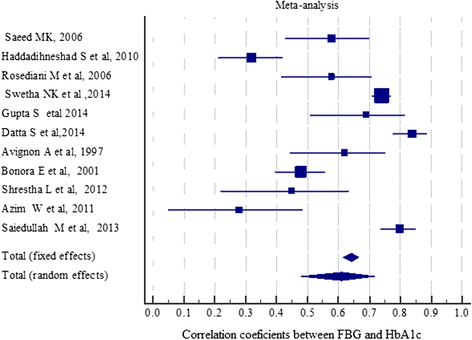Correlation of fasting and postprandial plasma glucose with HbA1c in assessing glycemic control; systematic review and meta-analysis
- PMID: 26413295
- PMCID: PMC4582842
- DOI: 10.1186/s13690-015-0088-6
Correlation of fasting and postprandial plasma glucose with HbA1c in assessing glycemic control; systematic review and meta-analysis
Abstract
Background: Glycemic control in diabetes mellitus is a cornerstone in reducing morbidity and mortality of the disease. Achieving glycemic control or reducing hyperglycemia significantly decreases the microvascular and macrovascular complications of diabetes. Even though measurement of glycated hemoglobin (HbA1c) remains the gold standard for assessment of glycemic control, there is no consensus whether fasting or postprandial plasma glucose (PPG) is a better predictor of glycemic control in resource-poor settings when HbA1c is not available. The aim of this systematic review and meta-analysis was to summarize evidences on the significance of fasting and postprandial plasma glucose, and their correlation with HbA1c.
Methods: Relevant studies were identified through systematic search of online databases (e.g. EMBASE, MEDLINE/PubMed and Cochrane library) and manual search of bibliographies of the included studies. Original research papers describing the correlations or associations of fasting and postprandial plasma glucose with HbA1c were included. The MedCalc software was used for data entry and analysis. We used the random effect model to estimate the pooled correlations of fasting and postprandial plasma glucose with HbA1c. Heterogeneity assessment and robustness analysis was also performed.
Result: From total 126 articles identified, 14 articles were eligible for systemic review. Eleven of these eligible studies evaluated the correlations of fasting and postprandial plasma glucose to the standard HbA1c values and used in meta-analysis. Seven of these studies (63.5 %) found better or stronger correlations between PPG and HbA1c than fasting plasma glucose (FPG). In all the studies that estimated the relative contribution FPG and PPG to the overall hyperglycemia, decreases in PPG was accounted for greater decrease in HbA1c compared with decreases in FPG value. PPG also showed a better sensitivity, specificity and positive predictive value than FPG. The pooled correlation coefficient (r) between PPG and HbA1c was 0.68 (P < 0.001, 95 % CI; 0.56-0.75) slightly higher than pooled correlation coefficient of FPG (r = 0.61(P < 0.001, 95 % CI; 0.48-0.72)).
Conclusion: PPG has a closer association with HbA1c than FPG. Hence, PPG is better in predicting overall glycemic control in the absence of HbA1c.
Keywords: Correlation; Diabetes mellitus; Fasting plasma glucose; Glycemic control; HbA1c; Postprandial plasma glucose.
Figures



References
-
- Sarah JB, Soma SN, Margaret J, Jeremy M, Shiva S, Charles M. Adequacy of glycemic, lipid, and blood pressure management for patients with diabetes in a managed care setting. Diabetes Care. 2004;27:694–8. - PubMed
-
- Vinod Mahato R, Gyawali P, Raut PP, Regmi P, Singh KP, Raj Pandeya DP, et al. Association between glycaemic control and serum lipid profile in type 2 diabetic patients: Glycated haemoglobin as a dual biomarker. Biomedical Researchm. 2011;22(3):375–80.
LinkOut - more resources
Full Text Sources
Other Literature Sources

